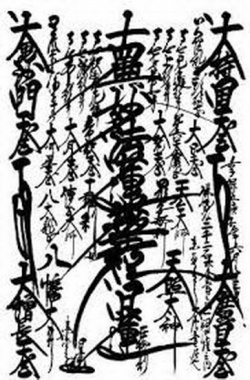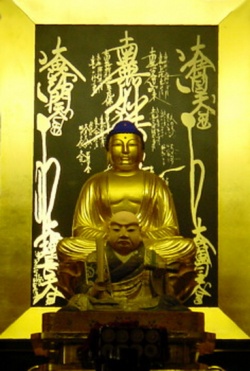O'Mandalas by St. Nichiren
Nichiren Shonin Gohonzon Shu
O'Mandalas by St. Nichiren
[1222-1282]
Early Mandala inscribed by Nichiren
Myoho Renge Kyo is not only the title of the Lotus Sutra but also the name of the Dharma itself. It is the core of the Lotus Sutra, the symbol of Nichiren Buddhism, the seed of Buddhahood to be sown in the minds of those who must be saved. We can say that the Purified Saha-world is the Palace of Sakyamuni Buddha because he is the Great King of the Dharma, and that the Myoho Renge Kyo is the Royal Standard hoisted on the roof of the Palace of the Great King of the Dharma.
Nichiren designed and wrote the Great Mandala. The word mandala means "circle." The Great Mandala can be translated as the Perfect Circle. When handwritten, however, it is a rectangular ideography of this Purified Saha-world described in the Kanjin-honzon-sho.
The Most Venerable One, the Original Sakyamuni Buddha, lives in the Purified Saha-world. And the Great Mandala is an ideography of this Purified Saha-world. Therefore, the Great Mandala itself is not the Most Venerable One. But the Imperial Palace sometimes stands for for Emporer; and the "White House" is a synonym for the President of the United States. In the same manner, the Great Mandala is sometimes called the Most Venerable One. Especially in Japan, where mentioning by name is considered to be impolite, Dai Mandala or Omandala ("O" is an honorific prefix), which means the Great Mandala, is popularly called Honzon or Gohonzon ("Go" is an honorific prefix), which means the Most Venerable One.
Nichiren wrote many copies of the Great Mandala, of which 125 copies are preserved undamaged. None of them, however are identical. This variety shows us the development of Nichiren's thought. The earlist copy is dated the ninth day of the tenth month of 1271, within a month of the Tatsu-no-kuchi Incident, when Nichiren was almost executed. The latest copy is dated the sixth month of 1282, four months before his death. The eight earliest copies, supposed to have been written before the eighth day of the seventh month of 1273, which is said to be the date of his first writing of the Great Mandala, are considered to have been written as a study. The copy dated the third month of 1280, which is now preserved at Myohonji Temple in Kamakura, is regarded [by Nichiren Shu] as the most significant one Nichiren had intended to inscribe. This copy is now designated as the Shutei Honzon, the "Gohonzon Authorized by the Nichiren Sect."
The most conspicuous item of the Great Mandala is the Myoho Renge Kyo, ir more precisely, the characters: Namu Myoho Renge Kyo, inscribed in the center. The Myoho Renge Kyo inscribed here is the Dharma itself, the core of the Lotus Sutra, rather than the title of the Lotus Sutra. But as stated previously, even Nichiren often times referred to the Dharma as the "Daimoku." Therefore, it is admissible to say that the Daimoku or Odaimoku is in the center of the Great Mandala.The Daimoku is also called Gendai or Shudai.
The Daimoku is the symbol of the Purified Saha-world of the Original Sakyamuni Buddha, the Royal Standard of the Palace of the Great King of the Dharma. Where there is the Daimoku, there is the Buddha. Even when the Emporer is in the field, the presence of the Imperial Standard indicates the whereabouts of the Emporer. Even when the Great Mandala is not fully inscribed or not written at all, the existence of the Daimoku represents the Buddha. Hence, Ippen Shudai no Gohonzon or "Gohonzon of the Daimoku Only" can be lawfully established.
Manual of Nichiren Buddhism by Rev. Senchu Murano. Nichiren Shu HQ: Tokyo. 1995. pp. 57-59.

